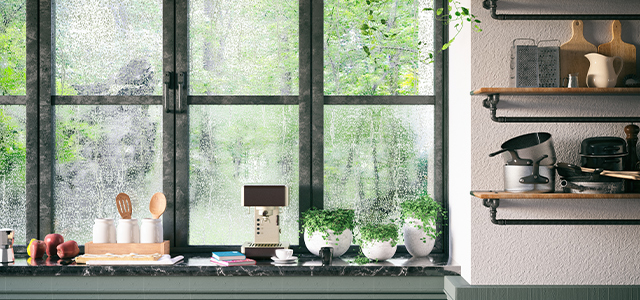The last thing you want to worry about when the rain starts pouring is for water to seep into your house. A few simple preparations will help you make sure that your home stays weather and water proof so you can enjoy the relaxing pitterpatter of raindrops on windows and not the anxiety-inducing drip-drip of a leaking roof!
Clean and repair gutters and downspouts
If your gutters and downspouts become clogged with debris the water falling on your roof will end up spilling over your eavestroughs right next to your home. This is the last place you want water building up, as it’s much more likely to find its way into your basement or cause damage to your foundation.
Ensuring it has a clear path away from your home is the first and best step in avoiding any unwanted side effects of the rain.
If you’re comfortable with the height of your roof you can grab a ladder and make your way up to the gutters to inspect them. Clear out any built up leaves and organic material and keep your eyes peeled for rust, holes, and other damage.
Similarly, inspect your downspouts. Run some water down each of them and make sure it’s able to flow without impediment. If the water seems to be getting caught up along the way, you might need to put some effort into clearing it out.
You can use a garden hose to snake the downspout to clear it out from the top. Just turn the water and work the hose downward until you make it to the bottom.
Check and repair weather stripping on doors and windows
Keep the draught out and the heat in during summer storms by ensuring your windows and doors are properly sealed.
There are several types of weather stripping on the market, from wood to metal and foam to plastic. There are pros and cons to every variety, but all will wear out eventually.
The easiest to install is adhesive-backed foam stripping, but this will only last one to three years before needing to be replaced.
Interlocking metal weather stripping, on the other hand, will provide you with the best seal but is complex to install and more expensive than other options.
Regardless of the type of weather stripping you have, it’s worth inspecting and repairing all of it in your home before the rain starts falling.
Test your sump pump
Your sump pump is an important line of defense against rising waters below your home. Located below your home’s foundation in a specially designed sump pit, the pumps are designed to automatically turn on once the water level reaches a certain height. Its job is to pump water out of the pit and away from your home’s foundation.
If, for some reason, the pump isn’t working, flooding could occur in your basement.
Twice a year, you should test your sump pump by pouring a bucket of water into the sump pit. Once the water level rises above the top of the sump pump, the float arm should activate the pump and quickly suck the water up and away from the house.
If the pump fails to activate, have it serviced.
Trim your trees
Tree branches look much prettier when they’re attached to a trunk than when they’re lying on the hood of your car or poking through your bedroom window.
Trees that have been weakened by droughts are more susceptible to being snapped by heavy rains or broken by high winds.
An arborist will be able to identify any areas of the tree that need to be trimmed, and will be able to help you direct the new growth of your trees to areas that will be most beneficial for the plant and your home.
Inspect your roof and siding
You don’t need to climb all the way up onto your roof to do this, although it will provide you with a better picture of the state of your roof if you can.
Instead, grab a pair of binoculars and walk around the exterior of your home inspecting the edges of your shingles and the seams in your siding. On newer homes you shouldn’t have to worry about any damages in these areas, but as your home ages you’ll want to make sure no issues are cropping up.
As always, it’s more cost effective to perform preventative maintenance than to pay for damages after the fact. By keeping a close eye on the state of your roof, you’ll avoid the slow creep of water damage through your attic and into your ceiling, which is a headache you certainly don’t want to have to deal with.
Enjoy those rainbows!
Once you’ve done the work of rain and weather proofing your house, you won’t have to worry the next time the weatherman calls for a thunderstorm. Instead, you can simply relax and look forward to the rainbow.



